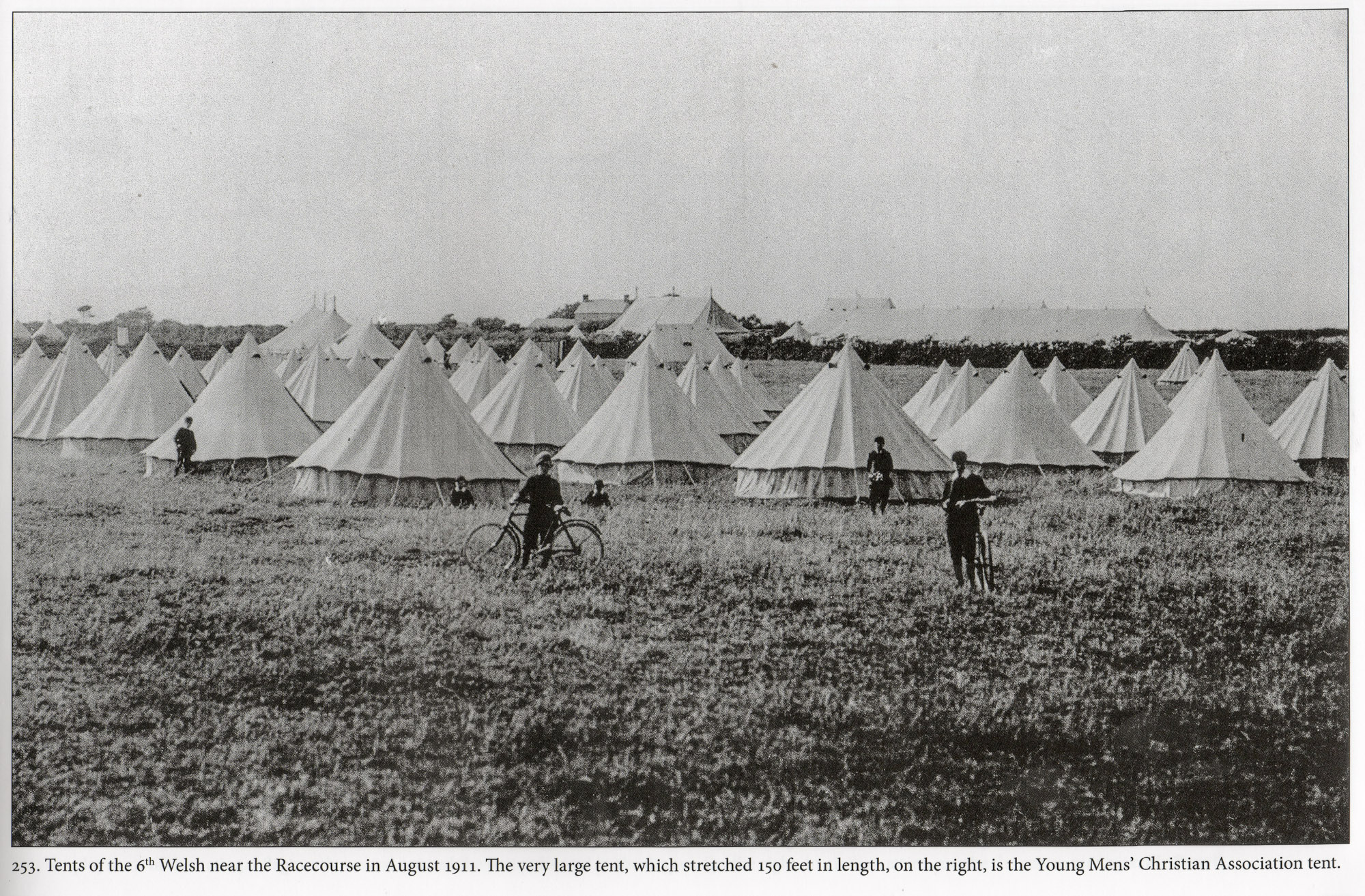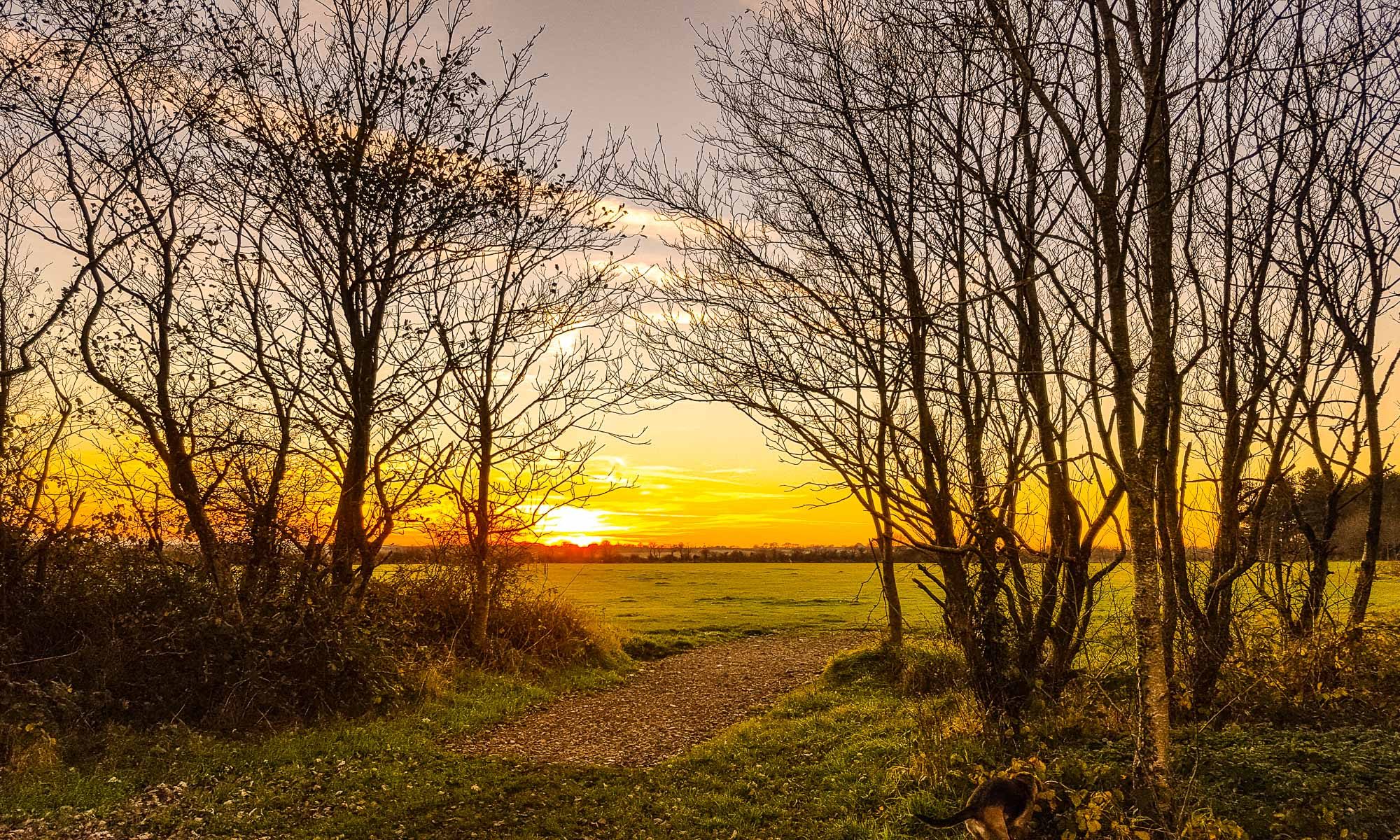The following excerpts are taken from “A Photographic History of Victorian and Edwardian Haverfordwest 1860 – 1914” with the kind permission of the author, Simon Hancock, who is the curator at the Haverfordwest Museum.
Horse Racing

Horse racing was the sport of kings and was the oldest sporting pursuit in the locality, stretching back to the laying out of the Racecourse for that purpose in 1727. For well over a century and a half horse racing was actively, if intermittently, enjoyed and attracted the landed classes and farming community from all over south Wales. In 1744 the racing meeting encompassed the ancient but barbarous contests of cock fighting where purses of two guineas were offered for the winner of each battle. A nautical theme often featured in some of the eighteenth century race meetings. In 1773 a boat race (for the prize of a Folkestone cutter) was added to make the entertainment and sport even more varied. Some of the purses for winning horses were very substantial. In 1772 the sum of £50 in gold was offered by Sir Richard Philipps and William Edwardes for one race. The Haverfordwest Races, which featured in calendars of national race meetings attracted thousands of equine admirers but also the event had a rich social side which was a considerable draw in its own right. In 1845 the Assembly Rooms ‘were crowded with a galaxy of beauty and fashion, such is seldom seen in the county.’ A couple of years later one commentator noted the mania which existed for the national pastime of racing. In 1857 the evening ball saw dancing kept up until four o’clock in the morning, by which time every Terpsichorean devotee must have been well and truly exhausted. The races lapsed for some years and they were revived from time to time so as to represent novelty and excitement when racing resumed again. In April 1887 the races were re-started. That year the flat and hurdle races were instigated by Mr T.Ince Webb-Bowen and concluded with a celebratory dinner hosted at the Swan Hotel. Immense crowds came to see the races after the interval of years and they saw fine sport as the Race Plate, Steward’s Plate and other contests were keenly ridden. In 1890 pony and Galloway races were started at Portfield. Horse racing was a pursuit attended by significant risks. At least one jockey succumbed to injuries during the races and a number were badly injured. In 1899 one jockey, L.Oxenham, was hurt during the races when thousands of spectators witnessed exceptionally keen racing. The steeplechases held on 11 April 1901, conducted in wretched weather, and witnessed by only a small crowd saw the demise of the old Haverfordwest steeplechases although occasional races were held at the Racecourse for years to come. In September 1901 one commentator deplored the ‘degrading vice of horse-betting (which) has taken a firm hold in Haverfordwest.’
Cricket

Cricket has a long and proud tradition of being played in the town and is usually cited as one of the oldest clubs in Wales. On 18 January 1839 the corporation acceded to the request from John Higgon Esq and other gentlemen from the cricket club to allow them to level a spot of ground within the ring of the Racecourse for the purpose of forming a cricket ground. The young men were enticed to Portfield where they enjoyed ‘this manly and healthy game.’ It would be wrong to assume the linear, uninterrupted existence of a club, since many of the features of sporting associations at this time were of an ad hoc nature. By August 1860 there were senior and junior sections to the club and in August that year the club took a lease of the land from the Haverfordwest Corporation. By 1862 the cricket club was styled `Haverfordwest United,’ sounding more like association football rather than cricket. The local Boys’ Grammar School provided regular opponents and miscellaneous military units. The Royal Artillery based at South Hook (1874) fielded an eleven as did the Royal Welsh Fusiliers (1882) and 2nd Battalion of the Worcestershire Regiment (1888). By 1893 the club was in a parlous condition being £204,30 in debt, the deficit mainly incurred in repairing the grand stand. Mr Herbert Price was elected honorary secretary and a committee was appointed to manage the club’s affairs. In 1903 the annual general meeting was held at the Mariners’ Hotel and chaired by Mr R.T.P.Williams who first played cricket for the town in 1870. Notwithstanding the £7 10s. spent on the pavilion in 1904 the club was on a firm financial footing and attracting staunch local support. An intriguing gender contest was promoted by the club in 1905 during the wider general discourse of female enfranchisement when eleven women took on a side picked from the town team. The females captained by Miss Meares, won by one run, an Amazonian triumph which probably hushed the voices of any sarcastic and disparaging males. In 1905 a typical Haverfordwest eleven included J.W.Hammond, J.L.Lloyd, E.L.Day, C.H.Evans, J.S.O.Tombs, Roberts, Cooper, Gooding and Parkinson. The Haverfordwest team played all the local teams including contests against Neyland, Milford Haven, Williamston, Rosemarket and a whole raft of teams in the local cricket league. The club’s annual banquet represented a highlight in the town’s wide, and not merely sporting social calendar. In November 1910 one of the guests, Mr George Herbert Llewellin (of the churn works) spoke for many a Haverfordian when he ‘enumerated the national beauties of the town, and said the magnificent scenic panorama which surrounds it was as good as one could see in a lifetime.’ If this was hyperbole, it was understandable given the scenic relaxation of spectators on the Racecourse watching the cricket during the heat of a summer’s afternoon but cooled by a gentle breeze. In 1911 the team’s batting average was headed by C.L.Penn with a tally of 218 or an average of 19.8 per innings. The club’s best bowler was E.A.Baggott with 55 wickets, gained at an average cost of 4.7 runs each.
Military Activity

The pleasant rolling fields adjoining the Racecourse were an ideal situation for hosting military manoeuvres, drills and inspections. Occasionally large numbers of men would spend their two-week summer camp under canvas, doubtless boosting the local provision merchants and providing a comforting reassurance for civilians of the sturdy and steadfast nature of their armed forces. In July 1894 the South Wales Infantry Brigade, joined by the Pembroke Yeomanry, encamped in the Furzy Park at Portfield, where they ‘defended’ Haverfordwest against the 41st Regiment who advanced from Milford Haven via Johnston. After the war games a general inspection was held at the Racecourse where General Harrison carried out a close scrutiny of the men. In 1908 it was the turn of the Wiltshire Regiment to go into camp; the 7th Battalion of the Welsh Regiment, some fifteen officers and 320 men spent their training fortnight here near the Racecourse in 1910. Interestingly the unit consisted entirely of cyclists from Barry, Cardiff, Port Talbot and Bridgend. Sixty bell tents were also erected, a YMCA marquee and a host of ancillary ones, including a hospital tent were also erected. During their training the soldiers cycled down to Little Haven and Broad Haven, enjoying the fresh sea air and comradeship forged under canvas. They were well served by their postal facilities. On one day more than 450 letters and postcards were dispatched from the encampment.
On Saturday and Sunday, 29 and 30 July 1911 some 3,200 Territorial’s and 320 regulars arrived at Haverfordwest and marched into the fields at the Racecourse. In early August more men arrived boosting numbers to nearly 5,000 with General Lloyd commanding the division. The 2nd Welsh had a particularly trying journey before they arrived in town on 29 July. They undertook a fifteen mile march from Rosebush through blazing heat. Two men fainted near Prendergast, overcome with heat and exhaustion. Nevertheless, their physique and endurance were remarkable. Each man carried a 50 pound knapsack. The bandsmen did not get off lightly, since they had to carry their heavy instruments. The procession was headed by the regimental goat. The Brecknocks arrived in two detachments, preceded by the obligatory band. On 30 July, Haverfordwest railway station must have had the busiest day in its history as 3,000 men alighted from fourteen special trains bringing the 6th and the 4th Welsh, commanded by Colonel Beddoe. There were seven Territorial bands which prompted one keen local enthusiast and observer of matters military to compare the location with Salisbury Plain.
Special pipes were laid from the Racecourse to link up with the town’s water mains. The temporary creation of what amounted to a new, albeit temporary town, with thousands of men and horses needing facilities was a huge task for the army commissariat and local facilities. It seemed as though the whole of the town turned out to see their military guests. A deputation representing the borough council waited upon Colonel Parkinson cordially inviting the officers of the various battalions to a reception in the council chamber on 2 August 1911. In addition to drill, inspection and war gaming there was plenty of opportunity for the soldiers to compete against one another. On 10 August 1911 a team of 28 non-commissioned officers and men from each of the four battalions competed in a cross country run for a solid silver challenge bowl and medals. Wearing a greatcoat and carrying a water bottle, mess tin, haversack and 100 rounds of blank ammunition in the heat of a summer’s afternoon must have been a real test of endurance. The route started and finished at the cricket pavilion on the Racecourse and took in Withybush. The 6th Welsh representatives won the match in a time of two hours and twenty minutes. Great excitement prevailed the day before when Sir John French (1852-1925) Inspector General of the Home Forces paid a visit to the camp. He was Chief of the Imperial General Staff (1912-14) and later the first commander of the British Expeditionary Force in France (1914-15).
Book details
| Title | A Photographic History of Victorian and Edwardian Haverfordwest 1860-1914 |
| Author | Simon Hancock |
| Edition | illustrated |
| Publisher | BPR Publishers, 2010 |
| ISBN | 0955079519, 9780955079511 |
| Length | 647 pages |


